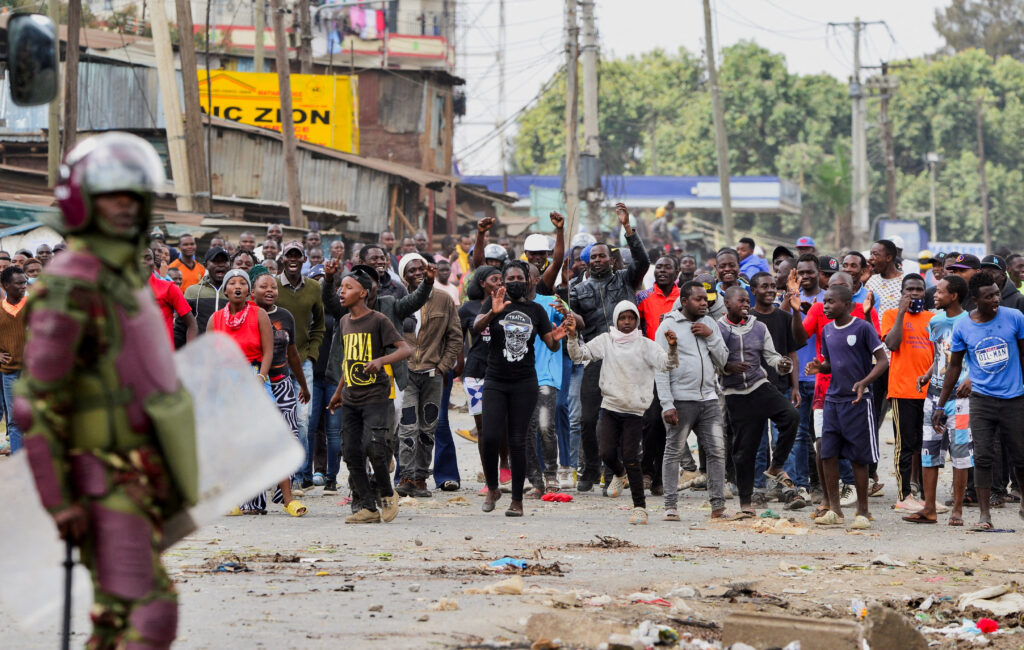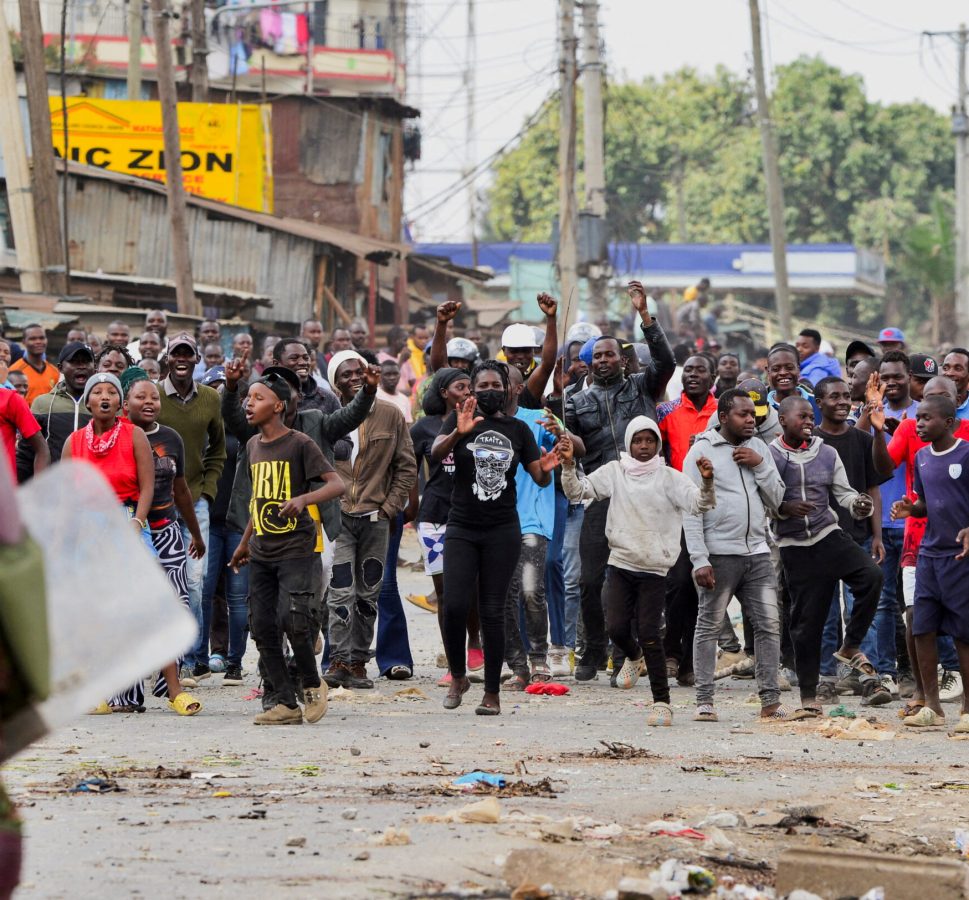
Weeks of antigovernment demonstrations demand an end to bad governance, corruption and for President Ruto to step down.
Nearly a month after demonstrations first erupted against President William Ruto’s government, police were using tear gas, water cannon and live bullets.
The city looked like a war zone.
Wambua stood out because he was unafraid and unapologetic about why he was on the streets.
“A president should be empathetic with his people. He is here because of us, not because of anything else,” the recent university graduate in his early 20s told Al Jazeera.
“Our parents back home worried about us. We are out here trying to fight for our own rights.
“I’m a student. Where do I go from here? Some of the people demonstrating are depressed, because there seems to be no future prospects for them,” Wambua said.
Four people were shot dead during the protests on July 16, allegedly by police.
The number of casualties has been on the rise since demonstrations first started, with more than 50 people killed since June, according to the Kenya National Commission on Human Rights.

Weeks of protest
Young, frustrated Kenyans first came out to protest against punitive tax proposals.
A contentious finance bill aimed to raise $2.7bn triggered many Kenyans.
At the height of it, demonstrators stormed parliament and burned part of it after MPs passed the controversial bill on June 25. Several people were killed that day – one right outside Parliament.
Since then, the protests have become a weekly affair.
President Ruto eventually succumbed to pressure and returned the bill to Parliament for further amendments. He has yielded to some demands made by Kenyans.
He fired cabinet secretaries but then reappointed half the cabinet – individuals some Kenyans rejected because they want the president to select technocrats with integrity, not political cronies. Ruto’s reappointments triggered more anger.
He promised several austerity measures to manage government expenditure and signed into law the process of reconstituting the Independent Electoral and Boundaries Commission. This would allow Kenyans to recall legislators they are unhappy with.
He has also been pushing for a national dialogue to form a government of national unity.
But the anger is not letting up.
Kenyans want him to deal with bad governance, corruption, mismanagement of public funds, and to step down.
“We’re not asking for something that cannot be achieved,” Wambua said.
“The president is asking us to go sit down with him in State House and dialogue. To talk about what? He asked for the job, he should have known what he was supposed to do. He should just read the constitution.”
‘Kenya has changed’
Ruto came to power on a populist sway in 2022 and appealed to young marginalised groups.
His campaign platform embraced what he called a bottom-up approach to prioritise millions trying to make ends meet. His message spoke to street hawkers, motorcycle riders and other small and medium-scale traders. They believed he would uplift them economically.
However, since then, they have seen increasing taxes, leading to a rising cost of living.
The government says it needs the tax revenue to, among other things, service a huge external debt pileup and avoid default.
Anthony Bhoke runs a popular show on X Spaces, called Home Run with Pipi.
He started it at the height of protests against another tax law in 2023.
At that time, people took to the streets against the tax measures the president signed and assented to despite the grievances.
“Kenya has changed. It’s not going to be the same again. It’s not going to be business as usual,” Bhoke told Al Jazeera.
“We are seeing our opposition and government sitting together and telling us they want to talk. It means the country is not asleep anymore. We are an educated class of jobless youth. It’s a very dangerous place to be. We need jobs and that is what the government needs to respond to. Otherwise, people will keep coming to the street.”
The young protesters say they are leaderless and, for the first time, their agitation goes beyond historic ethnic divisions. They also do not subscribe to any political party affiliations.
A majority of Kenyans support what is now popularly known as the Gen Z movement.
Bhoke said the young protesters are tech-savvy and have shown the power of digital activism, which is driving social change from screens to the streets.
“Through civic education, we are now getting the young people to understand these things. We are telling them: ‘Read this bill.’ We are telling them: ‘You go through the finance bill – appropriation bill – this is what you get.’ And through that, people started questioning, and then our friends on TikTok started amplifying them by reading to the people in vernacular.
“It’s a very segregated movement where nobody is a leader but everybody is leading in their own way.”

Excessive force
But the fact that there is no structure makes it easy for the group to be infiltrated by criminal gangs, as has been seen in recent protests.
Violence and looting have brought fear. Some Gen Z coordinators allege that the chaos is often sponsored by pro-government politicians.
Being on the streets has become dangerous for many of the young protesters who are largely peaceful as they carry little more than their flags, water bottles and smartphones.
Police have also been accused of using excessive force during protests, which has led to dozens of deaths. Some demonstrators are also missing or are said to have been abducted by police.
Kennedy Onyango was killed by a stray bullet in Ongata Rongai, in Kajiado county.
He was only 12 and had gone to get a textbook from a friend when clashes broke out in his neighbourhood. Autopsy results showed he was shot once in the shoulder and bled out.
Speaking to Al Jazeera in the aftermath, his mother Jocinter was heartbroken and their neighbourhood in shock.
“My son was an artist. He used to draw. He would often tell us his talent would take him to the best talent schools in the US. He believed his work would eventually take his family out of poverty,” Jocinter said.
Why did they shoot him, she asked, determined to get justice for her son.
Despite the lethal force used by security forces, young Kenyans are relentless in going out into the streets demanding change.
This Tuesday, there were more running battles as the demonstrations dragged into a sixth week.
The protesters’ message to President Ruto, the ruling class, politicians and religious leaders accused of complacency is clear: Do better or ship out.






